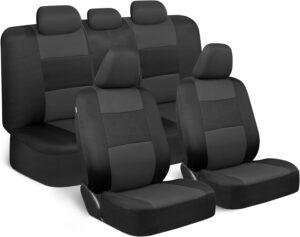Are you ready to hit the road but feeling a bit overwhelmed by the idea of driving for the first time?
Starting your driving journey can be both exciting and daunting, but with the right guidance, you can transform those initial jitters into confident skills behind the wheel. Whether you’re a complete novice or just looking to brush up on the basics, our comprehensive guide breaks down the essential steps to help you kick off your driving adventure smoothly.
5 Steps to Kick-Off Driving
From understanding the mechanics of your car to mastering real-world driving conditions, we’ve got you covered. Let’s dive in and get you ready to navigate the roads with confidence and ease!
Step 1: Understanding the Basics
Before embarking on your driving journey, it’s essential to grasp the fundamental concepts that will serve as your foundation. Recognizing the different parts of a car is a good starting point. Familiarize yourself with the steering wheel, which controls the direction of your vehicle, and the pedals: the accelerator, brake, and clutch (if driving a manual car). Mirrors are equally important; they offer necessary visibility of your surroundings to ensure safe maneuvering.
Understanding road signs and signals is another crucial aspect. Road signs provide information and instructions that ensure the orderly flow of traffic, while signals, such as traffic lights and pedestrian crossings, regulate the movement of vehicles and pedestrians. Familiarize yourself with common signs and signals to navigate the roads safely.
Basic driving terminology is also vital. Terms such as “blind spot,” “right of way,” “yield,” and “merging” are part of everyday driving vocabulary that you need to understand. These terms will help you communicate effectively with other drivers and comprehend driving instructions better.
Knowing traffic rules and regulations forms the backbone of safe driving. Each region may have specific rules, but some universal principles apply everywhere, such as obeying speed limits, using signals when turning or changing lanes, and not driving under the influence of alcohol or drugs. Adhering to these rules not only keeps you safe but also builds audience loyalty as a responsible driver.
The significance of a valid driver’s license cannot be overstated. It is not merely a legal requirement but a testament to your knowledge and competency as a driver. Acquiring a driver’s license involves passing both written and practical tests, designed to ensure you understand traffic rules and can apply them effectively.
By mastering these basics, you set a solid foundation for your driving journey, paving the way for more advanced skills and techniques. Understanding these elements is the first step towards becoming a confident and competent driver, ready to navigate the roads safely and responsibly.
Step 2: Preparing Mentally and Physically
Driving is a multifaceted skill that requires both mental and physical preparation. To effectively navigate the complexities of the road, it is crucial to stay calm, focused, and confident. Developing these mental attributes is key to becoming a competent driver. One practical tip is to practice mindfulness techniques, which can help you remain composed under various driving conditions. Additionally, visualization exercises can mentally prepare you for different driving scenarios, enhancing your readiness and confidence.
 BDK PolyPro Car Seat Covers Full Set in Charcoal on Black – Front and Rear Split Bench for Cars, Easy to Install Cover Set, Accessories Auto Trucks Van SUV
BDK PolyPro Car Seat Covers Full Set in Charcoal on Black – Front and Rear Split Bench for Cars, Easy to Install Cover Set, Accessories Auto Trucks Van SUV
- PROTECTS AGAINST WEAR & TEAR – These are the perfect seat covers for your new car, or even a car that’s just new-to-you. Our car seat covers provide protection against daily wear and tear that occurs inside of your vehicle.
- BREATHABLE MATERIALS – We use specially selected materials for maximum comfort during your daily commute. The high-quality poly outer layer provides enhanced ventilation so that you stay cool and comfortable during your drive.
- STYLISH DESIGN – Refresh the look of your vehicle and turn some heads along the way. This full set of seat covers features a stylish two-tone design with stitched accents, making it easy to add a splash of color to your interior.
- EASY TO INSTALL – The best investment for your new vehicle might also be the quickest. Follow the included installation instructions and videos on this page to install the front seat covers before finishing off with the rear bench seat cover and headrest covers.
- UNIVERSAL FIT – Our seat covers are designed to fit most vehicles including cars, trucks, vans and SUVs. Please see the product images for fitment examples. Some additional work may be required to create a ‘perfect’ fit. This includes accommodations for seat belt buckles and other built-in features.
Equally important are the physical aspects of driving. Maintaining good posture is fundamental, as it directly impacts your ability to control the vehicle and react swiftly to unexpected situations. Ensure that your seat is adjusted to a position where your back is fully supported, and you can reach the pedals comfortably. The headrest should be aligned with the back of your head to prevent whiplash injuries in case of sudden stops.
Adjusting your mirrors is another critical step. Properly positioned mirrors minimize blind spots and maximize your field of vision. Make sure the rearview mirror gives a clear view directly out the back window, and side mirrors are adjusted to just show the edge of your car, providing a wide view of the lanes beside you. Familiarity with the car’s controls, such as the location of the indicators, wipers, and lights, is essential. Spend time getting comfortable with these controls to avoid fumbling while driving.
Moreover, the significance of a good night’s sleep cannot be overstated. Fatigue impairs reaction times and judgment, making it one of the leading causes of accidents. Equally, staying sober is non-negotiable. Alcohol and drugs severely impair cognitive functions and motor skills, making driving extremely dangerous. Always ensure you are well-rested and sober before getting behind the wheel. By preparing both mentally and physically, you lay the groundwork for a safe and confident driving experience.
Step 3: Learning the Controls and Techniques
With your mental and physical readiness established, the next step is to acquaint yourself with the basic controls and fundamental techniques of operating a vehicle. The first essential aspect is understanding how to start the engine. Typically, this involves turning the key in the ignition or pressing the start button while ensuring the car is in ‘Park’ or ‘Neutral’ and your foot is on the brake.
Next, familiarize yourself with the gear shift. In an automatic vehicle, you will primarily use ‘Drive’ to move forward, ‘Reverse’ to move backward, ‘Neutral’ when the car needs to roll freely, and ‘Park’ when the car is stationary. Manual transmissions require more interaction, involving a clutch pedal and gear lever to switch between gears.
The accelerator and brake pedals are crucial for controlling the vehicle’s speed. The right pedal is the accelerator, which increases speed, while the left pedal is the brake, used to slow down or stop. Applying gradual pressure on these pedals ensures smooth transitions and enhances safety.
Steering is another fundamental skill. Hold the steering wheel firmly with both hands, typically at the 9 and 3 o’clock positions. This grip provides optimal control and maneuverability. Turning requires a hand-over-hand or push-pull technique for maintaining smooth and controlled movements.
Parking involves knowing how to maneuver your car into a designated space. Practice parallel parking, angle parking, and perpendicular parking to gain confidence. Merging into traffic, especially on highways, necessitates signaling your intentions, checking blind spots, and adjusting your speed to match the flow of traffic.
 Mobil 1 Advanced Fuel Economy Full Synthetic Motor Oil 0W-20, 5 Quart
Mobil 1 Advanced Fuel Economy Full Synthetic Motor Oil 0W-20, 5 Quart
- Mobil 1 Advanced Fuel Economy full-synthetic motor oil 0W-20 is low-viscosity to help improve fuel economy.*
- Utilizes Mobil 1’s signature Triple Action Formula to deliver outstanding engine performance, protection, and cleanliness
- Helps protect critical engine parts for up to 10,000 miles between oil changesm,** controlling oxidation to prevent oil breakdown and maintaining excellent viscosity
- Meets ILSAC GF-6 standards to help provide low-speed pre-ignition (LSPI) and timing chain wear protection while keeping your engine clean
- Helps extend engine life by working to prevent damaging deposits and sludge buildup
Handling common driving scenarios, such as stop-and-go traffic, requires patience and attentiveness. Maintain a safe following distance, anticipate stops, and accelerate smoothly. For highway driving, stay in your lane, use mirrors frequently, and be mindful of speed limits and road signs.
By mastering these controls and techniques, you’ll be well on your way to becoming a confident and competent driver. It’s vital to continually practice and refine these skills to ensure safety and proficiency on the road.
Step 4: Practicing in a Safe Environment
When it comes to mastering the art of driving, practice is paramount. For beginners, finding the right environment to hone their skills is crucial. Opting for safe and controlled settings such as empty parking lots and quiet residential streets can significantly reduce the stress and risk associated with early driving experiences.
Starting with an empty parking lot provides an ideal space to get accustomed to the basic operations of the vehicle. Initially, focus on simple tasks such as starting and stopping the car, using turn signals, and adjusting mirrors. These fundamental actions lay the groundwork for more complex driving maneuvers. An empty parking lot offers ample space to practice steering, accelerating, and braking without the pressure of other vehicles or pedestrians.
 EcoNour Car Windshield Sun Shade | Reflector Sunshade Offers Ultimate Protection for Car Interior | Cool Reflective Sun Blocker Fits Small Sedans, Mini SUVs, & Hatchbacks | Medium (64×32 inches)
EcoNour Car Windshield Sun Shade | Reflector Sunshade Offers Ultimate Protection for Car Interior | Cool Reflective Sun Blocker Fits Small Sedans, Mini SUVs, & Hatchbacks | Medium (64×32 inches)
- Protects Your Car Interiors: We know that the sun heat can be exhausting to you as well as to your car. EcoNour Car Sun Shade for Windshield is effective against harmful UV rays from damaging your car’s interior accessories. It is super durable and convenient to use.
- Superior Sun Protection: EcoNour’s Sun Shield for Car offers outstanding automotive interior sun protection. Thanks to the high-quality, durable 240T sun blocker screen protector material, your car’s interior temperature will stay at an optimum level, making it ideal with windshield sun shade SUV.
- Easy to Use and Fold: Unlike other car windshield sunshades, our foldable Car Window Shade Front Windshield is extremely versatile in nature. You can pop up the sunshades, install them, fold them back, and store the sun shade inside the storage pouch with ease!
- Provides a Snug Fit: Our automotive window sunshades, including sunvisor for cars windshield, measuring 64 inches of length and 32 inches of width are adjustable and can fit well for car windshields that do not exceed the measurement of 64 inches x 32 inches.
- Wide Range of Sizes: Worried about which sunshade size to choose? EcoNour’s SUV windshield sun shade auto accessories come in seven different size variants that would fit right into most family-sized four-wheelers. Please refer to the size chart for the best fit
Once comfortable with the basics, transitioning to quiet residential streets is the next step. These areas typically have lower traffic volumes, making them suitable for practicing driving in a more realistic setting. Here, beginners can work on understanding road signs, adhering to speed limits, and navigating through intersections. It is crucial to practice these skills repetitively to build muscle memory and confidence.
As proficiency grows, it’s time to tackle more challenging maneuvers. Parallel parking, for instance, requires precision and patience. Practicing this in a controlled environment will help in mastering the technique before attempting it in busier areas. Similarly, performing three-point turns and parking on hills are essential skills that can be practiced in quiet surroundings.
Having an experienced driver or instructor present during practice sessions cannot be overstated. Their guidance and immediate feedback are invaluable. They can provide practical tips and correct mistakes in real-time, ensuring the learner adopts safe and effective driving habits. Additionally, their presence enhances safety, offering reassurance and assistance if unexpected situations arise.
Step 5: Navigating Real-World Driving Conditions
After building a solid foundation in a controlled environment, the next crucial step is to transition to real-world driving scenarios. This phase involves driving in varied conditions and situations to gain comprehensive experience and confidence.
Driving in Traffic
Navigating through city traffic can be daunting for beginners, but it’s a necessary skill. Start by choosing times with moderate traffic to avoid overwhelming congestion. Practice maintaining a safe following distance, using your mirrors frequently, and signaling well in advance before changing lanes or making turns. Patience is key here—remember to stay calm and composed, even if other drivers are in a rush.
Highway Driving
Highway driving introduces higher speeds and more complex traffic patterns. Begin by driving on highways during off-peak hours when traffic is lighter. Focus on merging smoothly into traffic, maintaining a consistent speed, and using your mirrors to stay aware of surrounding vehicles. Always stay in the right lane initially and move to the left lanes only when you feel more comfortable. Practice exiting the highway safely by signaling early and decelerating gradually.
Night Driving
Driving at night presents unique challenges due to reduced visibility and increased reliance on headlights. Ensure your headlights are clean and properly aligned. Practice driving in well-lit areas before attempting darker roads. Use your high beams appropriately, but remember to switch to low beams when there’s oncoming traffic. Pay extra attention to pedestrians, cyclists, and animals that might be harder to see in the dark.
Adverse Weather Conditions
Adverse weather conditions such as rain, snow, and fog require special attention and adjustments in driving techniques. In rain, reduce your speed to prevent hydroplaning and increase the distance between you and the car ahead. For snowy or icy roads, drive slowly and brake gently to avoid skidding. Foggy conditions necessitate the use of fog lights and maintaining a slower speed. Always be prepared for sudden changes in weather and adjust your driving accordingly.
Interacting with Other Road Users
Real-world driving involves interacting with other road users, including pedestrians, cyclists, and motorcyclists. Always yield to pedestrians at crosswalks and be mindful of cyclists in bike lanes. For motorcyclists, maintain a safe following distance as they can stop faster than cars. Using your indicators clearly and making eye contact where possible can help ensure your intentions are understood.
Building Confidence
Gaining confidence in real-world driving takes time and practice. Start with shorter trips and gradually increase the distance and complexity of your drives. Reflect on each driving session and identify areas for improvement. Don’t hesitate to revisit quieter areas to practice specific skills if needed.
Seeking Additional Training
Consider enrolling in an advanced driving course or taking a few lessons with a professional instructor. These courses can provide valuable tips and techniques for handling more complex driving situations and further boosting your confidence.
By gradually exposing yourself to various driving conditions and consistently practicing, you’ll become a well-rounded, confident driver ready to handle the diverse challenges of the road. Remember, the goal is to be a safe and responsible driver, prioritizing your safety and that of others at all times.
Now loading...






